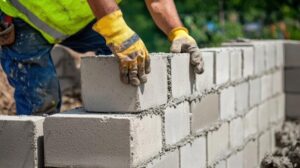Masonry construction is gaining attention for its adaptability in today’s building needs. The method uses natural or manufactured units bound together by mortar. These units can include stone, brick, or concrete blocks. It’s a system that has evolved but still thrives in modern architecture.

The strength of masonry lies in its structural integrity and thermal mass. It absorbs heat during the day and releases it at night. This helps regulate indoor temperatures without relying heavily on energy. It’s a silent champion in passive design strategies. Visit Our Website Here to learn more.
Many modern buildings are now combining old masonry techniques with new materials. This includes integrating insulation layers and reinforcing steel. These adjustments improve both durability and energy efficiency. It allows the structure to meet new environmental standards.
Another benefit of masonry construction is its resistance to natural elements. It stands strong against high winds, fire, and pests. This makes it suitable for structures that require long-term resilience. It also reduces the need for frequent maintenance.
A growing trend in masonry is its use in eco-conscious projects. Builders now favor local, recycled, or repurposed masonry units. This minimizes transportation emissions and construction waste. It supports the global shift toward sustainable development.
Innovations in mortar composition are changing how masonry behaves. Some mixes now include eco-friendly additives that reduce carbon impact. Others are engineered for better bonding and faster curing. These modern mortars improve both speed and quality.
Digital modeling is revolutionizing how masonry is designed and executed. Architects use Building Information Modeling to visualize layers before construction. This leads to precise material planning and fewer errors. It helps save time and cost without sacrificing quality.
Masonry construction also supports modular building systems. Prefabricated units can be assembled on-site in less time. This approach streamlines large-scale projects like schools and housing. It balances speed with traditional durability.
The aesthetic appeal of masonry continues to attract designers. Its textures, colors, and natural patterns offer timeless elegance. Many choose exposed masonry as a design statement. It serves both structural and artistic roles.
Thermal imaging tools now assist in maintaining masonry efficiency. These tools detect areas of heat loss or moisture intrusion. With this information, repairs can be done more accurately. It prevents minor issues from escalating into major damage.
Masonry also excels in sound insulation properties. Its density blocks out external noise, creating a quiet environment. This feature is ideal for urban dwellings and offices. It improves comfort without the need for extra materials.
Masonry walls are also excellent for load-bearing functions. They can carry significant weight without deformation. This reduces the need for excessive steel or support systems. It leads to cost-effective and space-saving designs.
Water resistance is another feature that can be improved with treatments. Special coatings and admixtures repel water while preserving breathability. These upgrades protect interiors from mold and damage. They also extend the life of the structure.
New training methods are enhancing skills in masonry application. Virtual reality modules and augmented reality tools are now used. These help workers practice before setting foot on-site. It reduces learning curves and improves safety outcomes.
Automation is entering the masonry field through robotic systems. Machines can now lay bricks with precision and consistency. While human oversight is still needed, productivity is significantly improved. This is especially useful in repetitive or high-volume projects.
Earthquake-resilient masonry is becoming a vital innovation. Engineers are studying how to design blocks and walls that absorb shocks. Reinforcement systems and flexible mortars contribute to this. The goal is to create safer buildings in active seismic zones.
Climate-responsive masonry is another exciting development. Materials are being designed to adapt to temperature changes. These include blocks with phase-change materials embedded inside. They store heat and release it slowly for better thermal regulation.
Masonry can be combined with smart sensors for building monitoring. These sensors detect structural shifts, cracks, and moisture. Data is sent to maintenance teams for immediate response. It introduces a proactive approach to building care.
The economic lifespan of masonry is unmatched in the construction world. Structures made from it can last over a century with proper care. This reduces the need for rebuilds and major renovations. It’s a long-term investment that benefits both users and developers.
Cultural relevance remains tied to masonry’s historic roots. In some communities, it symbolizes permanence and legacy. Modern construction respects this by preserving historic aesthetics. It blends the past and future in meaningful ways.
The use of thin masonry veneers is becoming more popular. These offer the appearance of solid masonry with reduced weight. They’re easier to install and need less structural support. It opens up masonry design for high-rise buildings and interiors.
Masonry is now part of green building certifications. Structures using sustainable units and low-emission mortars earn higher scores. This recognition helps builders access green funding and incentives. It’s pushing the industry toward more responsible practices.
Energy simulations help optimize masonry wall systems. Software can test different wall thicknesses and materials. The result is a structure tailored for specific climate zones. This ensures comfort and efficiency are maximized.
Masonry’s fire-resistant quality continues to be a selling point. It does not burn or emit toxic fumes. In emergencies, it buys time for evacuation and reduces fire spread. Insurance companies often reward such construction with lower premiums.
Research is also exploring how to make masonry carbon-neutral. Concepts include using bio-based blocks or carbon-absorbing mortars. These innovations aim to make the material part of the climate solution. It reflects the urgent shift to cleaner construction.
Lightweight concrete masonry is growing in commercial construction. It maintains strength while reducing load on foundations. This flexibility allows for creative structural designs. It also makes transportation and handling easier.
The reusability of masonry units contributes to circular economies. Bricks and stones can be cleaned and reused from demolition sites. This reduces demand for new resources and lessens landfill waste. It reflects a full life cycle approach to materials.
Masonry cladding is expanding into prefabricated panel systems. These panels are assembled off-site with insulation and finishes included. On-site installation becomes faster and cleaner. It aligns with lean construction principles and urban timelines.
Acoustic testing is refining how masonry is used in theaters and schools. Certain block shapes and cavity arrangements optimize sound flow. These configurations reduce echoes and improve speech clarity. It’s a scientific approach to comfortable environments.
Masonry’s thermal lag makes it suitable for hybrid energy systems. It works well with solar heating and natural ventilation. During cool nights, walls release stored heat to keep interiors warm. It complements renewable strategies without extra technology.
Specialty finishes on masonry surfaces are evolving. Nano-coatings offer self-cleaning and pollution-resisting properties. This keeps buildings looking new with minimal effort. It supports urban aesthetics and reduces long-term cleaning costs.
The rise of vertical masonry gardens is worth noting. Walls are designed to hold soil and support plant growth. These structures combine greening with natural insulation. It’s a functional and beautiful urban design trend.
Adaptive reuse of old masonry buildings preserves cultural identity. These structures are retrofitted with modern systems. It breathes new life into old shells while maintaining authenticity. Communities benefit from preserved landmarks and reduced waste.
Masonry arches and vaults are making a comeback in design. They are structurally sound and offer visual grandeur. Engineers now use 3D analysis to perfect curvature and load. It merges tradition with precision engineering.
Masonry plays a quiet role in disaster relief housing. Its materials are often locally available and affordable. In temporary shelters, it offers safety and dignity. The simplicity of construction also empowers communities to rebuild faster.
Waste from masonry production is also being repurposed. Crushed brick can serve as road base or concrete aggregate. Innovations like geopolymer blocks reuse industrial byproducts. This creates a closed-loop system for material use.
Daylighting strategies are enhanced by masonry’s thermal control. Buildings can feature larger windows without heat loss. Masonry buffers temperature swings and allows more natural light. It improves wellness and reduces artificial lighting use.
The flexibility in masonry design allows for creative facades. Architects carve patterns, curves, and reliefs into surfaces. These serve both functional shading and artistic expression. It makes each building a unique representation of intent.
New bonding patterns are being developed for efficiency. Interlocking systems minimize mortar use and boost alignment. This innovation speeds up construction while ensuring strength. It reduces labor costs and material waste.
Masonry has even found its way into furniture design. Small blocks are used in benches, counters, and decorative features. It merges construction with interior design seamlessly. This versatility extends the influence of masonry beyond walls.
Masonry construction continues to redefine itself in the face of modern demands. It blends durability, sustainability, and beauty like few materials can. With ongoing innovation, its relevance is not just preserved but expanded. The future of masonry is as solid as its very foundation.








